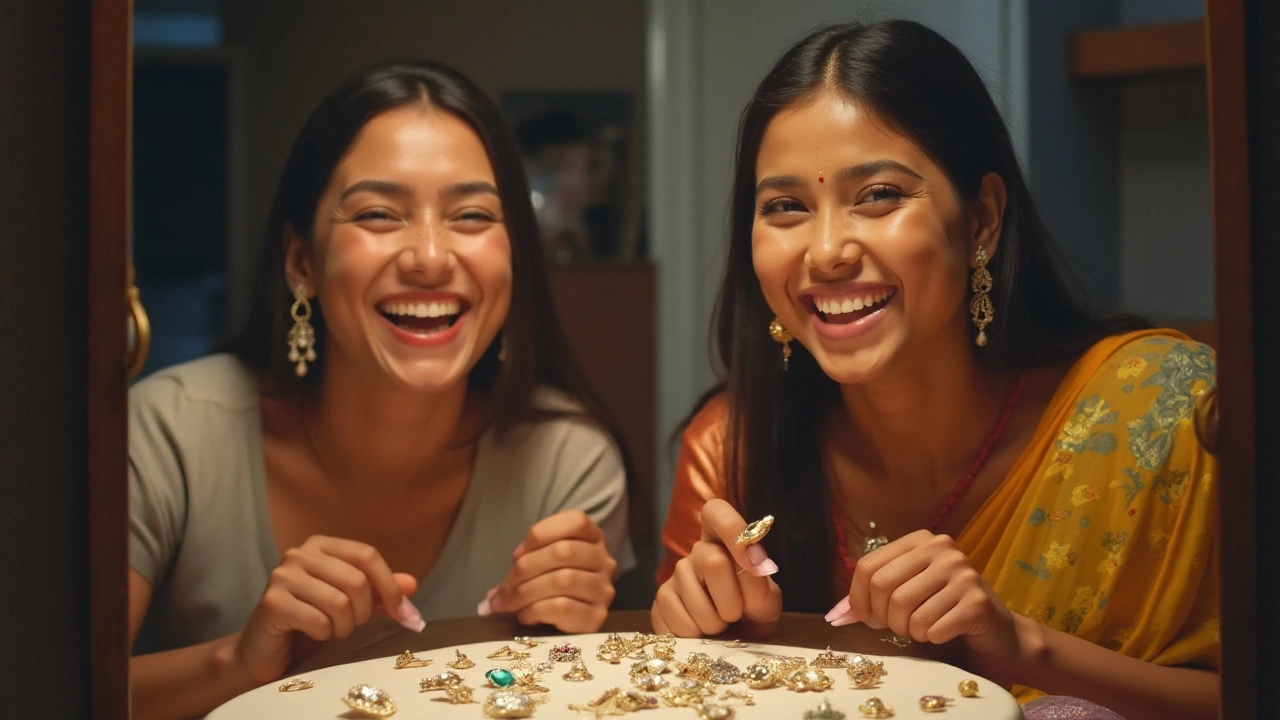
Nose piercings have been a symbol of beauty and individuality across cultures for centuries. Whether you're considering this form of adornment for personal expression or its aesthetic appeal, choosing which side of your nose to pierce can be significant.
While there is no universal rule, various factors such as cultural traditions, facial symmetry, and even comfort might influence your decision. In this guide, you'll discover insights into why some people prefer one side over the other and how this choice reflects in contemporary nose pin designs.
Beyond the initial choice, maintaining and showcasing your piercing involves understanding different nose pin styles and ensuring proper aftercare to flaunt your new look with confidence.
- Cultural and Historical Significance
- Facial Symmetry and Personal Preference
- Popular Nose Pin Designs
- Practical Tips for Nose Piercing Care
Cultural and Historical Significance
The practice of nose piercing can be traced back thousands of years, with its roots embedded deeply in historic traditions across various cultures. In regions of South Asia, particularly India, nose piercings are not merely a fashion statement but are interwoven with cultural beliefs and practices. Traditionally, women in India have pierced their left nostril, a choice linked to Ayurvedic medicine. It is believed in this system that the left nostril is associated with reproductive organs and can aid childbirth, easing menstrual pain, and representing fertility.
Similarly, in Middle Eastern and African cultures, nose piercings have been a symbol of wealth and status. The size and type of the nose pin design often speak volumes about a person's social standing and family lineage. This practice was often used to assert ethnic identity and passed down through generations as a ritual marking transitions in life, such as marriage.
On a different note, the punk movement of the 1970s and 80s in Western cultures adopted nose piercings as a form of rebellion. Breaking away from the conformity of mainstream aesthetics, they sought to challenge social norms. Today, while the cultural connotations are more relaxed, many individuals still choose to honor these rich traditions by selecting the side for their nose piercings thoughtfully.
Each culture brings its unique perspective, enhancing the depth and meaning behind the simple act of choosing which side to pierce. As Saskia Fairfull, author of 'Nose Rings: Fashion’s Sharp Versatile Ring', quoted,
"A nose piercing can transcend mere decoration and become a lighthouse of one's inner values and societal connections."Indeed, delving into these traditions enriches our understanding of why the choices we make today sometimes carry the weight of centuries of belief and practice.

Facial Symmetry and Personal Preference
Deciding which side of the nose to pierce can often come down to a matter of personal preference and how one perceives their own facial symmetry. For some, choosing the side that feels more natural or visually appealing is key to achieving a balanced look. It's fascinating to see how our perception of beauty tends to lean towards symmetry, where an even distribution of facial features often equates to attractiveness in the human eye. In fact, studies have suggested that people instinctively gravitate towards symmetrical features because it may be associated with good health or genetic fitness. So, when it comes to nose piercings, individuals often select the side that maintains or enhances their facial symmetry, complementing their overall appearance.
The left side of the nose has traditionally been the more popular choice due to historical and cultural influences, especially in Indian culture where it is thought to be associated with feminine energy and fertility according to Ayurvedic beliefs. However, this does not mean the right side holds any less aesthetic value. Some individuals, especially those right-handed, might choose the right to complement their dominant side, as it can often feel more natural or convenient. Your choice of piercing side can also depend on personal experiences or your unique style – maybe you simply feel your profile looks better with a piercing on a specific side. As a rule of thumb, ensuring you feel comfortable and confident with your choice is paramount.
Considerations like hairstyle or makeup preferences can also play a significant role. For instance, if you have a signature hairstyle that is often combed to one side, you might want to place your piercing on the side that stays more visible. This way, your nose piercing can serve as a focal point, complementing your personal sense of style. It's quite interesting to see how different celebrities have chosen sides based on their iconic looks – from the elegant swoop of a hairstyle that reveals a gleaming stud to an edgy vibe accentuated by asymmetrical elements.
Expert stylists and piercers can often provide valuable insights, and it might be helpful to visualize how a piercing on either side fits into your lifestyle. "Choosing the side for a nose piercing is a personal journey – embrace what feels right," says Dr. Sarah Jenkins, a cosmetic consultant.
"Style is an expression of self, and piercings like any other body art should reflect one's personality and artistry."Such personal touches can greatly influence the appeal and satisfaction one gets from their piercing decision. Ultimately, it's your face, your expression, and your canvas, so let your heart guide your choice on this personalized journey.

Popular Nose Pin Designs
The artistry of nose pin designs is as diverse as the cultures and individuals who embrace them. Over time, nose pins have evolved from traditional symbols to contemporary adornments, allowing for a broad expression of personal style. Jewelry designers across the globe continue to draw inspiration from cultural roots while infusing modern twists, resulting in designs that cater to a wide array of tastes and preferences. From delicate studs that hint at subtle elegance to extravagant hoops that make a bold statement, there is a nose pin to suit every personality and occasion.
Sparkling Studs
One of the favorites among many is the classic nose stud. These designs range from minimalistic metal balls to intricate gemstone creations that catch the light in just the right way. Diamonds remain a perennial favorite, often chosen for their timeless allure and brilliance. Other gemstones, such as sapphires and emeralds, offer hues that can complement one's eye color or even match an outfit for a cohesive look. In recent years, there has been a resurgence of interest in using ethically sourced or lab-grown stones, which align with growing concerns about sustainability and ethical practices in the jewelry industry.Nostalgic Hoops
Nothing quite rivals the appeal of a well-crafted nose hoop. Often seen in bohemian and traditional styles alike, hoops can add an edge to any look. Many designs are adjustable and easy to wear, embracing everything from simple gold bands to elaborate creations with ornate details. Some artisans craft bespoke pieces featuring filigree work or incorporate cultural motifs that hold significant meaning. “The hoop design is not just a trend, but rather a revival of ancient practices,” as noted in a feature in 'Jewelry Artisans Today.' This reclamation of historical designs speaks to the desire for authenticity in modern styling.Experimental Screws and Spirals
For those looking to push boundaries, screw and spiral designs are captivating options. These pieces often twist into place, providing a secure fit that’s perfect for those with active lifestyles. These designs add a textural element and can create dynamic dimensions on the face, enhancing the structure and symmetry of one’s features. Often crafted in sleek metals like titanium or silver, they may also incorporate minimalist patterns or engravings that offer a personalized touch.Although many prefer traditional gold or sterling silver, contemporary markets have witnessed an influx of materials that challenge these norms. Silicon, hypoallergenic metals, and bio-materials are becoming popular, especially among those who suffer from metal sensitivities. These alternatives provide a viable option without sacrificing style or quality. Given the vast landscape of choices, finding the right style can be both an exciting and daunting task. Many who delve into the world of nose piercing find themselves exploring multiple styles over time, each reflecting different phases of their fashion journey.

Practical Tips for Nose Piercing Care
So you've decided to add a *nose piercing* to your style, and now it's time to ensure you care for it properly. The aftermath of a piercing is crucial since improper care could lead to infections, discomfort, or an elongated healing process. Initially, it's essential to recognize that patience is your best friend during this phase. Most nose piercings take between 4 to 6 months to heal completely, so staying informed and diligent can help you avoid complications. Regularly cleaning your piercing is non-negotiable. Use a saline solution made from sea salt dissolved in warm water - preferably sterile. Gently rinse your piercing and the surrounding area twice daily to remove any bacteria or debris.
Nose piercing requires careful cleaning, yet it's equally important not to over-clean the area. Striking a balance is key, as overzealous cleaning might irritate the tissue. Another critical aspect is never twisting or turning your jewelry, especially in the early days. This common mistake can tear the skin, leading to prolonged healing or infection. To avoid unnecessary irritation, always handle your piercing with clean hands. Consider purchasing single-use sterile wipes to clean your hands before any contact. If you suspect any signs of infection, such as redness, swelling, or unusual drainage, seeking advice from a professional piercer or medical practitioner promptly is wise.
"The right care transforms a simple nose piercing into a timeless expression of individualism," notes Dr. Emily Stone, a renowned dermatologist specializing in body modifications.
Alongside cleaning, consider the products you use on your face daily. Beyond the cleaning routine, choose gentle, non-alcoholic cleansers and toners that won’t come into contact with your new *nose pin design*. Opt for hypoallergenic products as they are less likely to cause a reaction. Hair sprays and facial creams should be kept at bay from the pierced area as they can potentially irritate. Additionally, hygiene goes hand-in-hand with choosing the right type of jewelry. Swapping jewelry too soon can hinder the healing process. It's best to wait until the piercing is fully healed before experimenting with different styles. Titanium and surgical stainless steel are top picks for initial jewelry as they are less likely to provoke allergies or infections.
Signs of a Successful Healing
As months progress, recognizing signs of successful healing can be encouraging. Some signs include a lack of redness and swelling, with only minor discharge around the *nose piercing*. Remember, your body does the heavy lifting when it comes to healing, so maintain a healthy lifestyle, staying hydrated and eating nutrient-rich foods which support skin repair. Avoid compromising your immune system with unhealthy habits. Exercising caution around your pierced nose, especially when changing clothes or during sleep, preserves your investment in style and personal expression. Remember, nose piercings are not a sprint but a journey. While it demands patience, the reward lies in the self-expression and beauty it brings.


